ASUS ML248H: Thin for the Win?
by Chris Heinonen on October 27, 2011 12:00 AM ESTViewing Angles and Color Quality
The ASUS ML248H uses a TN panel, and viewing angles are always one thing that suffers with TN. With the monitor on my desk and tilted back, I can see a color and brightness shift from top to bottom quite easily. I found myself wishing that I could either reduce the height to make the center of the screen more even with my eye level, or have it higher and tilted forward a bit to accomplish the same thing. This gets worse with the larger the TN panels as well, but the lack of adjustments available in the ML248H made it a bit hard to see sometimes.
I will note that the ML248H has a tilt adjustment, but my review unit had the screw that connects the base to the monitor go missing at some point. Because of this I couldn’t use the tilt mechanism without worrying the monitor would fall off the stand and potentially be damaged. It’s possible that with this adjustment the angle would not have bothered me as much, but I was not able to get a replacement screw in time for testing. I did find that a spare bolt I had laying around from IKEA was the correct threading to fit, but the connection wasn’t as tight as with the original screw.
Color Quality
Our color testing uses the same procedure as in previous reviews, specifically, we test before and after calibration using ColorEyes Display Pro with an Eye One Display 2 colorimeter. We’ll start with the out-of-box experience.
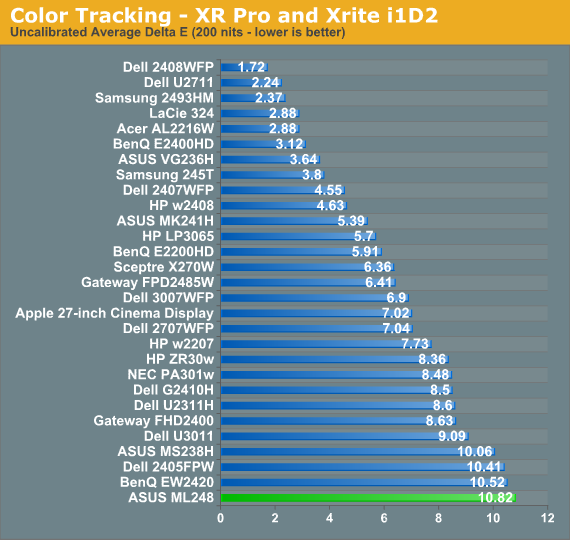
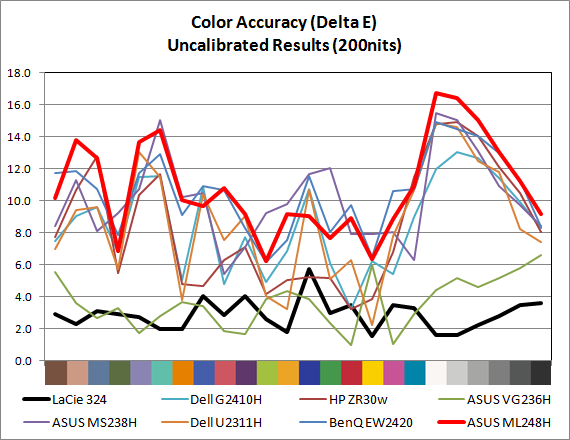
Pre-calibration, the ML248H suffers from a delta E (dE) over 10, with large errors across the whole spectrum. The grayscale is particularly bad, with errors all in the double digits. This isn’t too surprising at all, as most monitors ship this way—particularly budget (TN) displays.
For our calibrated readings, I used the Standard mode and the User color settings to get the white point as close to D65 and the light output at 200 nits (or slightly above) as possible. This was particularly tricky on the ASUS as when I adjusted the white balance, any change to the contrast would send the grayscale out of alignment and add a very blue tone to the image. I wound up having to choose a level around 210 nits of output before I calibrated the white point to allow myself the headroom to get the white balance correct and still be above 200 nits. You can also enable DDC control and get almost identical results to what I did by hand, if your hardware supports it, and save yourself a lot of time.
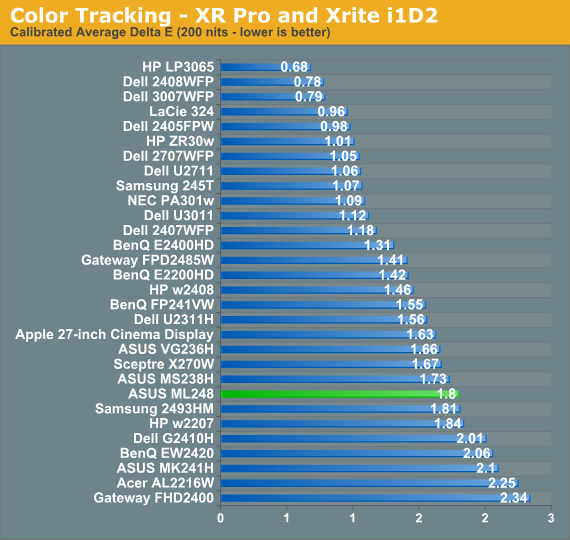
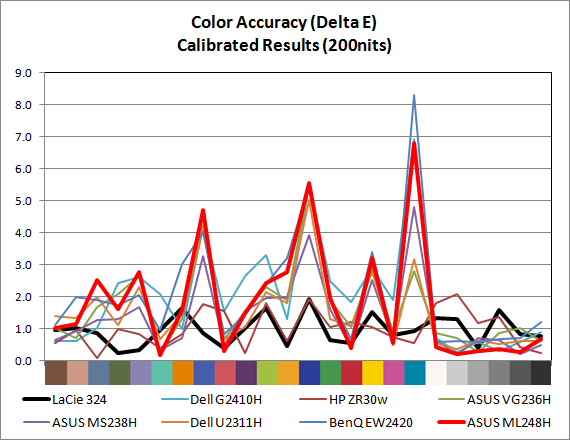
For a monitor targeting the sRGB colorspace, the ML248H does pretty well with a dE of 1.80 for the center. The maximum dE is 6.81, which occurs on a shade of cyan that does not fall inside of the sRGB colorspace, so there will always be an error unless the monitor can do the Adobe RGB colorspace. The median dE is only 1.32, which indicates that the majority of colors are closer to accurate than the average dE indicates, but a few are far off. These are typically blue heavy colors, often at the edge or outside the sRGB colorspace, and those are skewing the results as well.
Also looking carefully at the results, we see the grayscale values in the chart all have values below 0.43 dE, other than black which is 0.68 but also far more subject to measurement error due to its low light output. With all dE values above 3 falling in colors that are predominantly blue, and the grayscale being very neutral, color is overall pretty good on the ASUS. It’s not ideal of course, but it is better than the overall number of 1.80 might lead us to believe.
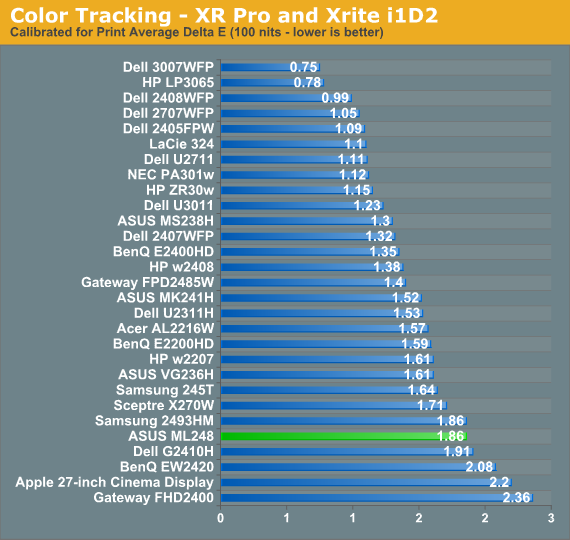
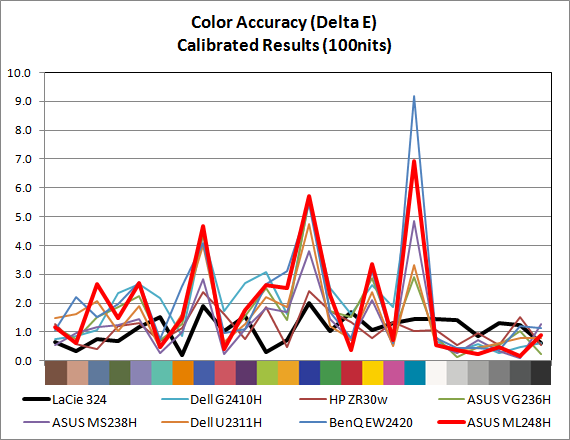
The result for 100 nits is almost identical. The dE is 1.86 on average, with a very good grayscale and issues with the blue samples that fall outside of the sRGB colorspace or at the edge of it. The LEDs don’t seem to discolor at higher or lower output levels, which is also good.















57 Comments
View All Comments
ssssss - Thursday, October 27, 2011 - link
Great article, have not read it. Wahoo.B3an - Thursday, October 27, 2011 - link
Shut up.And @ anyone at AT, can you introduce rules where you only review GOOD monitors. As in, nothing that has TN a panel. I know that will cut out a lot of stuff (AKA shit!) but theres still some good monitors out there that are actually worth reviewing.
Sabresiberian - Friday, October 28, 2011 - link
I disagree, I want to see companies get blasted in public for producing junk by reputable review sites like Anandtech and Tomshardware.I also want to know myself how these monitors perform.
As far as me actually buying another TN panel - well, there's the 120Hz panels, and if they get 2560x1440 0r 2560x1600 120Hz TN panels that are top notch for TN I might just bite, but otherwise they are off my list.
;)
ckryan - Thursday, October 27, 2011 - link
I really dislike TN panels. Hate it. But TN has always been awful, and now that it's better in 2011 than it was in 2003, it's still awful. e-IPS is the new TN -- able to slot into lower price points but with competitive (if not mindblowing) performance. In the laptop market you have to grin and bear it, but on your destop and in your pocket you don't have to. You can always choose a phone with an IPS screen, and now there are many more lower cost options for your desk. e-IPS and a few analogous VA paneled screens have at least decent viewing angles, color reproduction, and response times. e-IPS in particular is available in some dirt-cheap configurations with few options/no height or tilt/etc. and pricier products with more ergonomic functions and mo' betterness included. TN for desktop displays is really limited to 3D and 120HZ at the moment (I know some really like their TN panel displays, but there are cheap e-IPS options that are certainly worth a look). The U2311H and now the U23/2412 are midrange eIPS options, while NEC makes some much more expensive models. Asus and LG have some really decent eIPS models, and so I hope that prospective monitor buyers at least take a look at something other than a TN panel before making a buying decision. I hope that the explosion of mobile devices with great displays will leave people wondering why they put up with sub-par units in laptops and monitors.Asus makes this same chassis into displays with MVA and eIPS, in addition to the TN here. This monitor, in addition to it's two other-paneled siblings would make a nice article -- hint, hint _-.
MrSpadge - Thursday, October 27, 2011 - link
Agreed! A TN with an unergonomic stand so that you can not even try to work around its weak points. It doesnt even have a DVI output. So unintersting! Sadly someone will buy it..spellingmisteaks - Thursday, October 27, 2011 - link
I'm so over TN panels. With IPS panels dropping close to 200 bucks, there's no reason to waste money on a TN panel.iSmug - Thursday, October 27, 2011 - link
Totally agree.The 24" A-MVA version is the same price. ML249H
The 23" e-IPS version is $10 cheaper. ML239H
I don't understand why anyone would want the TN version..
I own the ML239H. It was by far the cheapest option for the monitors with the same LG panel.
dingetje - Thursday, October 27, 2011 - link
TN + 16:9 panel = waste of reviewspaceDaduck - Thursday, October 27, 2011 - link
..and included with an ugly design. Agree completely.slick121 - Thursday, October 27, 2011 - link
Agreed. I don't know who they are targeting but I wouldn't want that on my desk.